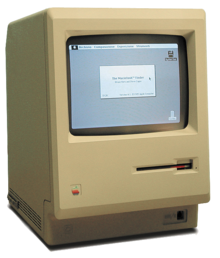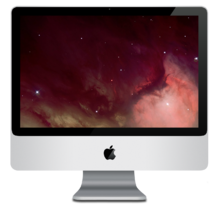The first photo was my first computer, the Macintosh. The screen and hard drive where all in one -compact unit. I used it for all my homework. It had a mouse and the selection of menus was intrinsic of Mac making it extremely user friendly instead of typing in commands in a command box.
The second picture is the computer I currently have, iMac with a 24″ screen – arrrg, arrrrg! The hard drive and screen are all in one, still.

The original Macintosh, the first commercially successful personal computer to use a graphical user interface, rather than a command line.

An iMac computer from August 2007, a modern all-in-one Macintosh.
The Macintosh (pronounced /ˈmækɨntɒʃ/ mak-in-tosh),[1] or Mac, is a series of several lines of personal computers designed, developed, and marketed by Apple Inc. The first Macintosh was introduced on January 24, 1984; it was the first commercially successful personal computer to feature a mouse and a graphical user interface rather than a command-line interface.[2] The company continued to have success through the second half of the 1980s, only to see it dissipate in the 1990s as the personal computer market shifted toward the “Wintel” platform: IBM PC compatible machines running MS-DOS and Microsoft Windows.[3]
Years later, Apple consolidated its multiple consumer-level desktop models into the 1998 iMac all-in-one. This proved to be a sales success and saw the Macintosh brand revitalized, albeit not to the market share level it once had. Current Mac systems are mainly targeted at the home, education, and creative professional markets. These include the descendants of the original iMac and the entry-level Mac mini desktop models, the Mac Pro tower graphics workstation, the MacBook, MacBook Air and MacBook Pro laptops. The Xserve server was discontinued January 31, 2011.[4]
Production of the Mac is based on a vertical integration model in that Apple facilitates all aspects of its hardware and creates its own operating system that is pre-installed on all Mac computers. This is in contrast to most IBM PC compatibles, where multiple sellers create and integrate hardware intended to run another company’s operating software. Apple exclusively produces Mac hardware, choosing internal systems, designs, and prices. Apple does use third party components, however, such as graphics subsystems from nVidia and ATi. Current Mac CPUs use Intel‘s X86-64 architecture; the earliest models (1984–1994) used Motorola‘s 68k and models from 1994–2006 used the AIM alliance‘s PowerPC. Apple also develops the operating system for the Mac, currently Mac OS X version 10.7 “Lion”. The modern Mac, like other personal computers, is capable of running alternative operating systems such as Linux, FreeBSD, and, in the case of Intel-based Macs, Microsoft Windows. However, Apple does not license Mac OS X for use on non-Apple computers.
Contents
[hide]

